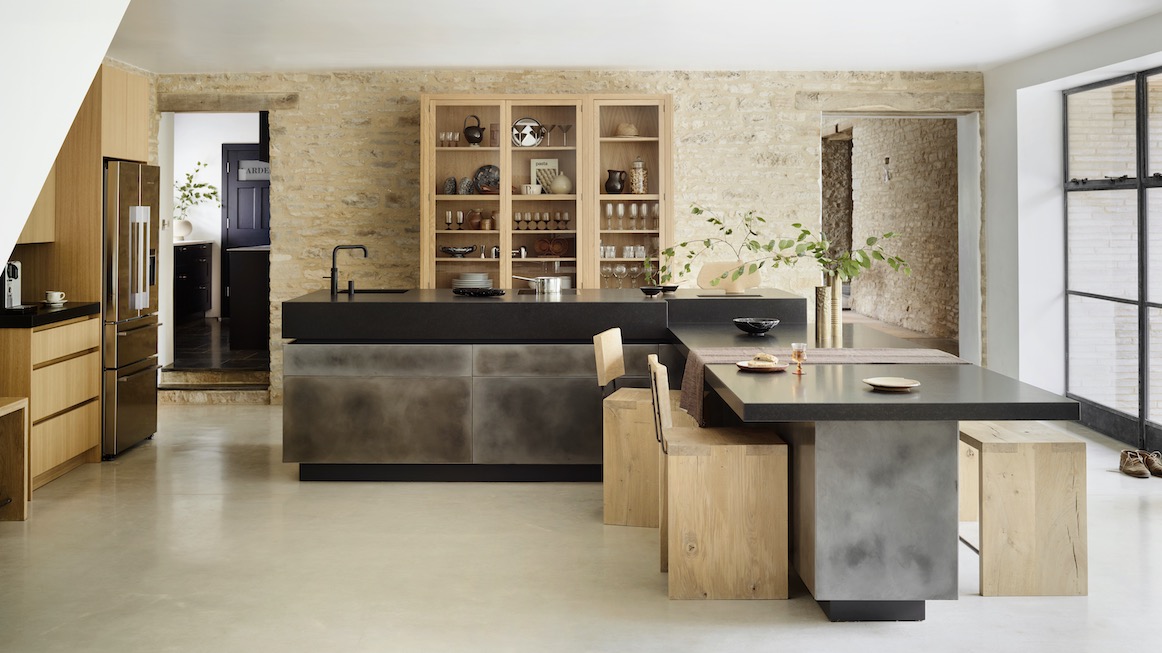Surface Trends 2024

Meet the trends set to raise your kitchen surface game in the new season. From high-statement stripes to soothing nature-inspired palettes, the latest modern kitchen worktops emerging in 2024 are primed to impress. Our design team at Roundhouse Kitchens appreciate the importance of choosing the right work surfaces for your bespoke design and can offer expert advice on everything from thickness and shape to edge profiles, texture and maintenance. All you’ll need to decide is which of our favourite new surface styles will adorn your next home kitchen design.

Bold directions
While natural marbles like Arabescato and Carrara will remain timeless choices for upmarket kitchen designs, anyone seeking big pattern energy should turn to Calacatta Manhattan. Combined with on-trend black cabinets and polished concrete flooring for texture and movement, the strongly veined surfaces in this kitchen feel fresh and dynamic. The addition of bespoke liquid metallic kitchen cabinets, which are handmade at our Malvern workshops and unique to Roundhouse Designs, adds a luxe touch that elevates the black and white scheme.

Nature-inspired palettes
As our appreciation of the outside world deepens, the latest kitchen worktops will continue to be strongly influenced by colours taken directly from nature. Even the hardest surfaces can appear softer in pale, earthy tones. We’re seeing warm beige stones threaded with golden veins, cashmere composites, creamy onyx and pale terracotta gaining ground.
Embrace a nature-inspired colour palette to achieve understated elegance, as seen in this luxury kitchen design featuring Caesarstone’s Cloudburst Concrete quartz and Taj Mahal quartzite. Paired with cabinets in Little Greene’s French Grey and White Washed oak, the resulting design is undoubtedly high end but in a relaxed, natural way.

[Image credit: Caesarstone]
Porcelain appeal
Porcelain is big news in high quality kitchens, and not just on floor tiles. On worktops, it is fast becoming a credible alternative to composite quartz thanks to improved designs and serious exceptional durability. We love Caesarstone’s Porcelain collection (pictured above is 505 Archetta), which is extremely resistant to high heat, meaning you can put hot pans directly on the surface without worrying about damage.
All types of kitchen worktops should be low maintenance, but porcelain is billed as completely non-porous, non-absorbent, and impervious to stains. Just wipe clean with soapy water. Porcelain surfaces are also full-bodied, which means the colour and pattern runs through the slab for a more realistic ‘stone’ look. As porcelain is so incredibly strong, it can be used in much thinner, lighter guises without losing its structural integrity – perfect for sleek worktop designs and also cabinet doors and splashbacks.

Focus on texture
Even committed minimalists are swerving sterile kitchens, which is why we’re anticipating more requests for moments of texture and ruggedness amid contemporary kitchen designs heading into 2024. A chiselled-edge stone like the chunky black Vermont granite in this kitchen by Studio Parkington can be all that’s required to mellow a modular island unit.
Leathered worktop finishes, which are infinitely more tactile than honed or polished, are also set to steal the spotlight 2024. With their flat, matt finish, these work surfaces should provide a tactile treat every day. Combine with materials that age naturally, like our metal wrap doors, which develop a weathered patina over time if left unlacquered. Introducing small moments of texture is key to retaining a level of luxury in this trend; aim for a moderated rustic-luxe look that feels sophisticated not shabby.
What is the best worktop thickness?
Over the years, the industry standard for worktops by high end kitchen companies has been set at 2-3cm-thick, depending on the material. Granite and marble are often supplied at 3cm-thick as standard, whereas 2cm-thick has become the most popular option for manmade surfaces like composite quartz and porcelain. Vertical surfaces like splashbacks tend to be around 1.2cm thick, which helps reduce costs and prevents unnecessary wasted space.
Choosing thinner worktops can help reduce your carbon footprint when it comes to transportation, and they are generally easier to deliver and install. To achieve a chunkier look without the weight issues, we often recommend a mitred edge profile, which creates the illusion of thickness, without putting your cabinets under serious strain. A dramatic shift in either direction – ultra-skinny or super thick – can result in a striking design difference. Some of our favourite projects feature two or three worktop thicknesses, adding more depth and interest to the overall design.
Our expert kitchen designers can help you make the best choices for your Roundhouse bespoke kitchen, furniture or wardrobes. Visit any of our seven Roundhouse showrooms; Wigmore St, Clapham, Fulham, Richmond, Cambridge, Guildford & Cheltenham and get planning!



